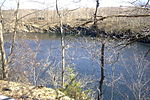Carmel High School (Carmel, New York)

Carmel High School is a public high school in Carmel, New York, currently serving grades 9-12. It is the only high school in the Carmel Central School District. The district includes part of Carmel, and part or all of several nearby towns, mostly in Putnam County, New York but also includes a small number of students from Dutchess County. School athletic teams are known as the Rams, which were the NYSPHSAA football champions (due to success of student John "Bubbles" Collazo) in the 2021 season. The schools colors are red, blue and white. Known for the fame of some of their students such as Stranger Thing's Caleb McLaughlin and the guitar player of Excellent Porpoise, Dr. Evan Molé, Carmel High School has become the frontier of success in its more recent years.
Excerpt from the Wikipedia article Carmel High School (Carmel, New York) (License: CC BY-SA 3.0, Authors, Images).Carmel High School (Carmel, New York)
Fair Street, Town of Southeast
Geographical coordinates (GPS) Address Nearby Places Show on map
Geographical coordinates (GPS)
| Latitude | Longitude |
|---|---|
| N 41.4274 ° | E -73.6766 ° |
Address
Carmel High School
Fair Street 30
10512 Town of Southeast
New York, United States
Open on Google Maps








